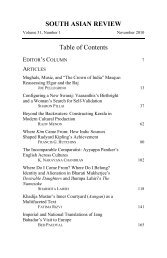2010 Winter Newsletter - South Asian Literary Association
2010 Winter Newsletter - South Asian Literary Association
2010 Winter Newsletter - South Asian Literary Association
Create successful ePaper yourself
Turn your PDF publications into a flip-book with our unique Google optimized e-Paper software.
PAGE 7<br />
ABSTRACTS FOR 2011 SALA<br />
C ONFERENCE<br />
Hasan Al Zayed, East West University, Bangladesh<br />
Akhteruzzaman Elias and Realism<br />
Very few writers have been able to successfully negotiate the<br />
two limits realisms impose on writers: frame the truths of<br />
human existence, yet remain conscious about flow of time.<br />
Bangladeshi writer Akhteruzzaman Elias (1943-1997) was<br />
able to do both. This paper is an attempt to understand Elias’s<br />
stance on realism: how he struggled to capture the truth<br />
of collective existence but remained acutely sensitive to the<br />
way language, location, culture and labor keep affecting our<br />
existence. Elias’s fictions exhibit an understanding of realism<br />
which neither conforms to nor deviates from 19 th century<br />
European realisms or their subsequent derivatives. In fact,<br />
they rework the available examples of realisms – i.e. naturalism,<br />
socialist realism, magic realism, and so on – to concoct<br />
an entirely new breed of realism which is critical, insurrectionary,<br />
and wholly original.<br />
Waseeem Anwar, Forman Christian College University,<br />
Lahore, Pakistan<br />
Amorphous Realism: A Viable Context for Pakistani <strong>Literary</strong><br />
Text<br />
This paper explores the historical-cultural nature of amorphous<br />
amid contemporary postcolonial “unsettling” conditions<br />
in <strong>South</strong> Asia. As the indigenous in Pakistan multiplies<br />
our comprehension inability, the emerging spatio-temporal<br />
realities around pre- and post-partition frames transmogrify<br />
to re-echo Conrad’s: “The horror! The horror!” Readings<br />
here suggest that the Pakistani “real” has gone beyond the<br />
confines of geography, splitting ideologies into ideologues.<br />
Be it Forster’s muddle or Kipling’s magic-game of the Indo-<br />
Pak Subcontinent, the challenging complex trajectory of Bhabha’s<br />
“ambivalent” and Suleri’s “Amorphous” offers a viable<br />
context for Pakistani literary text.<br />
Elise Auvil, Ohio University, Athens, OH<br />
Representations of the Bene Israel Jews of India: A Study<br />
of the Works of Nissim Ezekiel, Esther David, and Carmit<br />
Delman”<br />
According to legend, two thousand years ago a ship wrecked<br />
and left one of the lost tribes of Israel on the coast of India;<br />
they became the Bene Israel Jews of India, literally meaning<br />
“children of Israel.” Until the eighteenth century, when they<br />
were “rediscovered” by travelers, the Bene Israel Jews succeeded<br />
in preserving a form of Judaism. The goal of this paper<br />
is to explore how authors Nissim Ezekiel, Esther David,<br />
and Carmit Delman portray the reality of the Bene Israel<br />
Jewish community through their use of various genres.<br />
Deepika Bahri, Emory University, Atlanta, GA<br />
NEWSLETTER<br />
Novel Realism: Rohinton Mistry’s Such a Long Journey<br />
Apt to engender "confusion of linguistic with natural reality"<br />
((De Man RT 11), mimesis in the Realist genre can be a<br />
risky trope for the postcolonial writer because it is associated<br />
with such terms as "copy," "reproduction," and "imitation,"<br />
and so in danger of contributing to rather than challenging<br />
the problems of fixed identity which postcolonial discourse<br />
has consistently struggled against. A whole set of conceptual<br />
exchanges can be precipitated in the reading of postcolonial<br />
Realist novels in a market driven by appetite for authentic<br />
stories about the other. This paper examines the textual complexities<br />
of mimetic representation in the novel Such a Long<br />
Journey by Rohinton Mistry, a writer associated with the realist<br />
tradition, and suggests that it is particularly important to<br />
read Realist fiction against the grain in the precise historic<br />
moment that demands representation from the postcolonial<br />
text.<br />
Mark Balmforth, Columbia University, New York, NY<br />
Façades of Pluralism: Use and Misuse of Myth vis-à-vis<br />
“Realism” Surrounding Chandrasiri's Dutugemunu<br />
In this socio-historical analysis I articulate the collision of<br />
history, memory, and modern politicking surrounding Sri<br />
Lankan director Jeyantha Chandrasiri’s historical epic film<br />
commemoration of second century BCE Sinhalese Buddhist<br />
hero-king and title character Dutugemunu, currently in production.<br />
I describe the significance of such a production in<br />
post-war Sri Lanka to explore the following questions: given<br />
the intensely contested nature of normative nationalistic and<br />
ethnically provocative articulations of the Dutugemunu<br />
mytho-history, whose reality is really being articulated?<br />
Moreover, can this case of modern mythologizing socially<br />
shift troubling paradigms of racial instigation under the auspices<br />
of building ethnic harmony?<br />
Manisha Basu, University of Illinois at Urbana-Champaign,<br />
IL<br />
“The Stuff that Realisms are Made on”: Global English<br />
and R.K. Narayan’s Painter<br />
In examining R.K. Narayan’s 1976 novel The Painter of Signs,<br />
my paper hopes to unsettle realist conventions of literature<br />
and thereby elude a colonially-inflected opposition between<br />
mythic and realistic narratives that has for some time pressed<br />
upon Narayan’s work, and more broadly upon Indian writing<br />
in English. The protagonist of the novel comes to be in the<br />
midst of Narayan’s characteristically bustling banality, but<br />
Narayan’s reality is not the objective life-world that houses<br />
his protagonist. Given that the novel ends with a lingering<br />
sense of how, with the painter of signs, we lose a way of<br />
thinking about the materiality of language, I will end my pa<br />
per with a consideration—in dialogue with Gayatri Spivak’s



